-
San Francisco Jewish Film Festival 2019
Last edited by Chris Knipp; 08-09-2019 at 12:59 AM.
-
WHAT SHE SAID; THE ART OF PAULINE KAEL (Rob Garver 2019)
ROB GARVER: WHAT SHE SAID: THE ART OF PAULINE KAEL (2019) CAPSULE
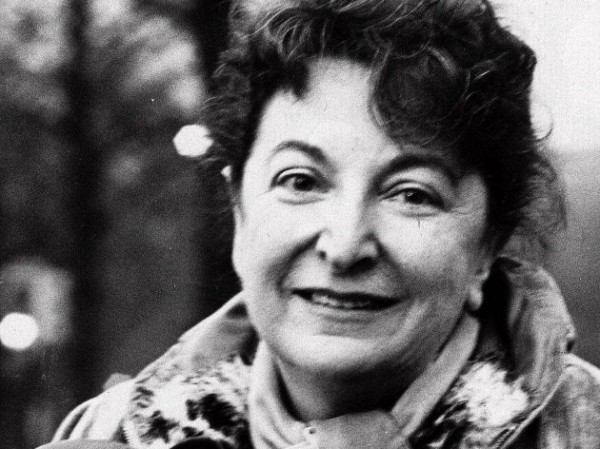
PAULINE KAEL
And she said a hell of a lot
Even if you have read a lot of Kael's movie criticism, there is a lot to learn about her. You realize she grew up when there were still silents. The menial jobs she had. That she had a child with the experimental filmmaker James Broughton. Paul Schrader said she was his second mother. What does that mean? That she was important. For a film reviewer who loves film reviews, she was unique. Those who ween't around when her reviews were being published can't imagine what it was like. Seeing this film will help them figure it out. She was smart, she was provocative (she could dare to be cruel), she was passionate, she had a huge memory of film. There's been nobody who's come close since.
What She Said: The Art of Pauline Kael ((2019), debuted at Telluride in Aug. 2018 and has shown at 18 festivals. It was screened for this comment (not a review) as part of the SFJFF (July 18-Aug. 4, 2019)
Showtimes:
Saturday July 20, 2019, 4 pm, CineArts
Sunday July 28 12 pm Castro Theater
Sunday August 4, 4:05 pm Piedmont Theater
Last edited by Chris Knipp; 07-27-2019 at 11:42 PM.
-
CARL LAEMMLE (James Freedman 2018)
JAMES FREEDMAN: CARL LAEMMLE (2018)'
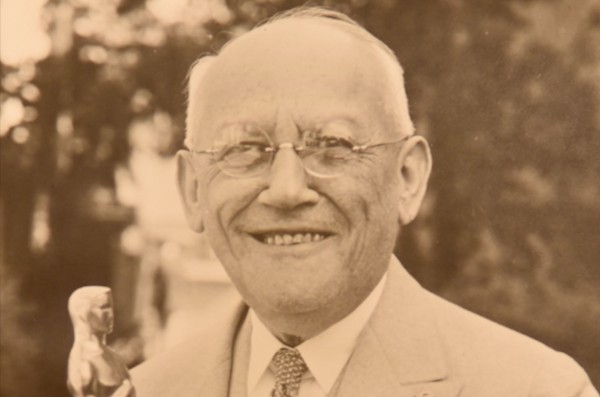
A great Hollywood motion picture story
ThOS is a slick promotional documentary film history narrated by great-grandniece, Antonia Carlotta Laemmle and by Bob Balaban and Peter Bogdonovich and several film historians. It sells us on the idea that Carl Laemmle is the seminal Hollywood personality we should all know about. As the director of Universal Studios (founded in Fort Lee, NJ in 1912, when he was 45), he was responsible for having 11 female directors working at one time, and sent out a movie with an African American woman and a Caucasian woman as business partners. With Boris Karloff and Bela Lugosi, he fostered a "humanizing" of monsters. The film goes back to Karl's emigration - sent by his father - to the US in the 1880's at the age of 17, and gradual progression of many jobs, starting as an errand boy in New York, then later for a while in Oshkosh, Wisconsin, which had a big majority of Germans. At first, he had spoken virtually no English.
Then at some point he began renting and selling films, starting out at that in Chicago, becoming a movie man, getting investors because of his entrepreneurial charisma. We learn of the monopolistic and manipulative business practices of Edison and Eastman in the early days of filmmaking - and of the fight of Laemmle and the other independents to compete with Edison's controlling "Trust." Edison exploited actresses; Laemmle stole them away and promoted them by their own names, such as Mary Pickford and Florence Lawrence, starting the star system, then founded his "Universal Studios." Edison sought to dominate the market by suing his rivals for patent violations. He sued Laemmle 289 times, but lost every time. The move from New York to California was partly done to get away from the eastern courts and under a more anti-trust regime. Also the sunny weather and 200 acres of a San Fernando Valley chicken ranch for the studios - which could still give eggs to visitors who paid for a studio tour to watch films being made.
Trouble came for Laemmle's Universal in the wave of anti-German fervor during WWI. German internment camps were set up - supervised by a young J. Edgar Hoover and Laemmle wound up making anti-German propaganda films for the government starring Erich von Stroheim as a negative stereotype. Yet Laemmle maintained his warm relationship with his beloved hometown in Germany, Laupheim. which didn't condemn him for the anti-German films and even named a street for him - Lämmlestrasse (hie original German name was Karl Lämmle).
Universal was perhaps the biggest studio in the world in the silent film era. In the late Twenties, Laemmle's son Carl Jr. took over management of the studio. He hired the son of a neighbor at his summer home in Edgemere, New York and made him his secretary: Irving Thalberg. Thalberg had a congenital heart disease and did't live beyond he age of 37, but he was brilliant, and became the "Boy Wonder" of movie production and discovered stars such as Rudolf Valentino, Stan Laurel, and Lon Chaney. He also became the model of F. Scott Fitzgerald's The Last Tycoon. Lois Weber was an important, activist director. Between 1912 and 1919 women directed 200 mostly feature films at Universal. Laemmle's trust and risk taking got him two major Oscar winner directors, John Ford and William Wyler (the latter imported from Mulhouse, northeastern France).
Laemmle's extraordinary nepotism- he had 70 relatives on the payroll at one point - culminated in hiring his son Junior as studio director, but Junior was hard working and talented. He pushed asked Westerns and slapstick and brought in monster movies, prizewinning ones like The Hunchback of Notre Dame, Phantom of the Opera, The Man Who Laughs plus Dracula and Frankenstein.
This film has a lot to say about the Thirties and the rise of HItler, which made Laemmle pull out of Germany professionally and personally (while other studios didn't). The great pacifist hit All Quiet on the Western Front was a key moment, driven out of the theater by Hitler's Storm Troupers. Then Laemmle Senior began focusing on the project of getting his many relatives - and lots of other Jews - out of NaziGermany. The Nazis were happy to see them go; the trouble was, they were not welcome elsewhere. He got them into America by giving them jobs at Universal. By 1936 Carl and Junior were forced out of Universal due to financial failures and neither made any more movies. Uncle Carl had done a lot of good. He died of a hart attack in 1939 at 72. Against difficult odds, he had saved 300 Jewish families from Nazi Germany. This seems like a labor of live by William J. Freedman, whose only other feature is the HBO bio Glickman about Marty Glickman, the first jock turned sportscaster, who faced anti-semitism in the Thirties to become outstanding in a new field. Like Laemmle. This walks us back over a bigger set of events.
Carl Laemmle, 90 mins., debuted at Miami Jewish Film Festival Jan 2019, also playing at Toronto Jewish Film Festival and the San Francisco one, at which it was screened for this review.
SFJFF showtimes:
Friday July 19, 2019 11 am Castro
Sat July 20 11:30 a.m. CineArts
Sat July 27 12 pm Albany Twin
Fri. Aug 2 2 pm Smith Rafael
Last edited by Chris Knipp; 07-17-2019 at 06:51 PM.
-
ECHO הד’ (Amikam Kovner, Assaf Snir 2018)
AMIKAM KOVNER, ASSAF SNIR: ECHO הד’ /HED (2018)
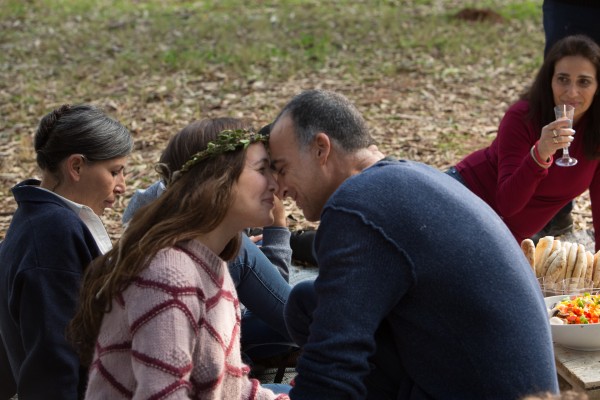
YAËL ABERCASSIS AND YORAM TOLEDANO IN ECHO
Home surveillance
In this Israeli film with a "noirish tone" (Hannah Brown in The Jerusalem Post) set in Haifa, Avner (Yoram Toledano), a chief engineer on the Carmel Tunnels project, discovers through a traffic report with a photo that his wife Ella (Yaël Abecassis), a shrink, may be having an affair.
Rather than confronting her, he spies on her by recording her phone conversations. As he listens over and over to these recordings, more and more - the movie wants to tell us - he comes to find his wife a stranger, their relationship a mystery. A Hebrew comment on Letterboxd says "A lot of genre, but it's a great movie." Regretfully, I must disagree. It's not enough genre, and despite interesting ingredients, doesn't generate sufficient excitement and winds up feeling flat. When Avner tells his two kids he has been "very angry" at their mother we realize we didn't feel that anger. He has to tell us, and he's telling us too late.
The directing team, who were working together for the first time, say they were inspired by Hitchcock's Vertigo, Coppola's The Conversation, and Kieslowski's Red. Excactly the trouble is that they're playing with a few too many ingredients, and the dish they've served up hasn't the strong clear, satisfying taste of that rare thing, neo-noir. "Noirish" it is, but that winds up being like slightly pregnant.
The opening shot is pointed and suggestive: a tunnel, one of the ones on the underground traffic shortcut network Avner is working on, and an explosion. It's a punchy intro. A little bit obvious, of course: Avner is going to be tunneling into the secrets of his marriage, and he's going to take apart its security and its structure forever. He is - spoiler alert - going to find out who his wife Ella was having an affair with. But she has disappeared from the action halfway through, muting the tensions. (This situation may have taken a hint by the Israeli film The Cakemaker by Ofir Raul Graizer, with its jointly aggrieved spouse and secret lover.)
Nothing about the phone conversations Avner records particularly stands out, not do they, like Coppola's film, have a quality of unfolding mystery. But he does do detective work, with some plausibility unraveling the chain of events that led Ella to meet the other man a little over a year earlier. Only the unfolding of this lacks the sense of drama and danger that accompany real noir.
The contrast between the steely, macho Abecassis (a cross between George Clooney and Boris Karloff) and the soft, unassertive Guri Alfi who plays the lover, hints at a pulpy effectiveness. The movie presents its upper middle class milieu suavely. The posh modern apartments, the glamorous birthday picnic, the roughhousing at the gym and Avner's anger at his sexy young coworker-pal Shay (Tsahi Halevi) when he advocates serial adultery. The key subplot of Ella's lost patient and his senile mother in care; the misconceptions of the cute, well brought up kids, Tali (Ron Zimmerman) and Dafna (Tamar Zur). The subtle widescreen images, equally glamorizing landscape and interior. This is sophisticated filmmaking with a consistently polished surface. But it lacks an edge, even a muted scream. It has so many possibilities, but it winds up disappointing.
Echo/ הד’ (Hed), 92 mins., debuted at Jerusalem July 2018, and is showing at 19 Jewish film festivals. It was screened for this review at the San Francisco one.
SFJFF showtimes:
Friday July 19, 2019 3:40 at the Castro
Mon. July 33 8:30 at CineArts
Sat. July 27 8:50 at Albany Twin
Last edited by Chris Knipp; 07-18-2019 at 12:30 PM.
-
ABE (Fernando Grostein Andrade 2019)
FERNANDO GROSTEIN ANDRADE: ABE (2019)
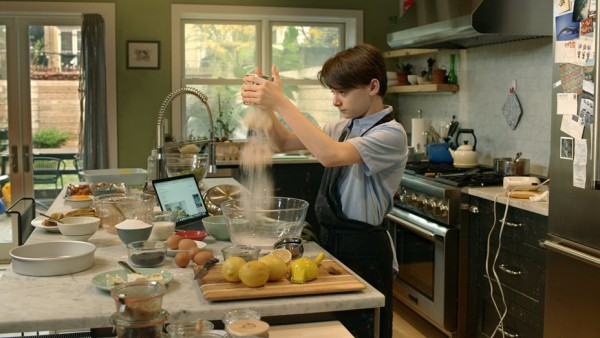
NOAH SCHNAPP IN ABE
Mixed cuisine
If you are not too demanding, this Sundance film may provide charming entertainment. But the trouble with it is that while geared ostensibly to youthful audiences, it contains political conflicts too bitter and intense to be pleasant or understandable for them, while the rest of the content is too simplistic for adults. The idea is reconciliation of family differences through cooking.
Noah Schnapp, "Will" in the series "Stranger Things," has sweetness, earnestness and charm in the lead role of one of those budding boy genius chef types who are popping up all over now. Flynn McGarry of the documentary Chef Flynn was about this age, just turned twelve, when he started his at-home subscription supper clubs. Abe, aka Abraham, Avi, Avram, or Ibrahim, isn't quite that ambitious yet. But when his parents try to send him to a Mickey Mouse summer cooking class for kids, he runs off and begs Chico (musician turned actor Seu Jorge), an Afro-Brazilian fusion chef, to mentor him. The apprenticeship segment is the film's simplest and best, when Abe has to wash pots and pans and put out the garbage, then gradually has his talent recognized and is granted an official apron.
The danger is that this will be construed as child labor, or something, or simply that, out of character, Abe is lying to his parents and doing this in secret.
Abe is a fusion dish himself. His father is Palestinian, his mother Israeli, and their Brooklyn household is frequently visited by all four in-laws. And they don't get along whenever politics is mentioned, which it is whenever they sit down together. Abe's effort to do a Jewish-Arab cuisine fusion meal for Thanksgiving, with a roast turkey which is neither, is such a diplomatic nightmare among parents and in-laws he runs away to Chico, and the stress of his disappearance unites the family's two sides. It's all very emotional and cute - and manipulative and fake. The versatile character actor Mark Margolis of "Breaking Bad" stands out as Benjamin, the macho Israeli grandad, who wants only for Abe to have his bar mitzvah and be an observant Jew. The boy's Palestinian-American father Amir (Arian Moayed) is an atheist. One feels for a kid pulled in so many conflicting religio-ethnic directions. But the treatment of this situation isn't realistic or specific enough to take seriously, even though the one big mealtime fight is disturbingly bitter.
I noticed that Josiah Hughes of Exclaim.ca finds the "online" visuals, meant to be trendy, used to depict on screen Abe's Internet food researches "through a series of zany hashtags, Impact-font memes and Tumblr notifications" is really retro, "the sort of outdated web interfaces that suggest Andrade [the director] "hasn't seen the internet since 2011." I simply saw them as annoying, as it always is when a film throws a mass of barely legible on screen crap at us to "read," when we actually can't.
The point of this stuff is valid though: to show how today's middle class American kid lives a life of Facebook and Tumblr and Tweets, when temporary "grounding" deprivation from his smartphone and laptop is worse than observing Ramadan. Abe admits he has few real friends, only online ones. Unfortunately whether or not ABe's web navigations are up to date, the massive amount of food porn fails to pay off, because the cuisine is too eclectic to be readable, or look appetizing.
Another aspect that eluded me is the music. Joe Bendel of of the movie review blog J.B.Spins knowledgeably lists the rich variety of Brazilian pieces that provide the soundtrack, including cast member Seu Jorge doing several songs, including one by the late Caetano Veloso, plus Tulipa Ruiz doing a number, and the film's "musical supervisor" Jaques Mandelbaum doing cello arrangements of Jobim. In the context I can't agree with Bendel that these "sound fantastic" because they wind up sounding schmaltzy, a part of the film's effort to manipulate our emotions. This, plus the various interesting actors, are indications that there are good materials here, waiting to be edited into a more effective whole.
Abe, 85 mins., debuted January 2019 at Sundance, playing also at Montclair. This is the 38-year-old Brazilian-born director's feature debut. The screenplay was penned by Arab-American theater director Lameece Issaq. It was screened for this review as part of the SFJFF.
SFJFF showtimes:
Saturday July 20, 2019 11:15 am Castro
Sun., July 28 11 am Albany Twin
TRAILER
Last edited by Chris Knipp; 07-20-2019 at 01:08 AM.
-
SAFE SPACES (Daniel Schechter 2019)
DANIEL SCHECHTER: SAFE SPACES (2019)
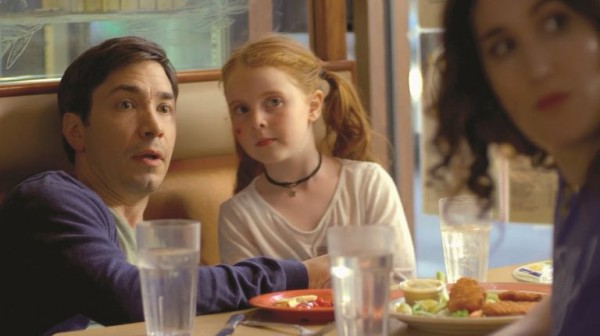
JUSTIN LONG (LEFT) IN SAFE SPACES
Plea for compassion - but what about taste?
A jejune but eager, up to date, and assertive "writing" teacher called Josh Cohen (Justin Long) who the festival blurb calls "a 38-year-old Brooklyn man-child" is an adjunct creative writing professor in New York City who tells a girl student in class to "write what hurts," which in this case turns out to be to describe a date where the boy asked her to let him jerk off on her butt and she did. The premise and scenes feel like the hip HBO anthology series "High Maintenance" except this is about a subject that's become trite of late: political correctness. While everybody uses foul language - college students in front of teachers in class, adult children in front of elders in a hospital - a writing student is criticized for including no people of color in a story that's about his Jewish summer camp. Well, there could be people of color at the camp, as employees. If an African American might be tricky, Josh suggests in private the student might try an Asian. In a smaller, seminar-style class, we learn from a militant African American woman student that for her, "hashtag" and "me too" take on a special, inferior meaning: she uses them to refer to a white male's feeble efforts to be politically correct.
The issue of "appropriate speech" is tossed around, as Josh is repeatedly hauled in to a faculty committee to rehash his discussion of the jack-off moment and the girl's objection that Josh's pressing the girl student to reveal it awakened painful memories of a sexually abusive experience of hers. Josh makes the situation worse for himself by refusing to apologize. Does anyone consider that, first of all, you can't really teach writing and second, Josh gives no evidence of knowing anything about this art? He is only seen, and then only briefly, discussing content, not the quality of writing itself. Can he put a sentence together? Does style matter to anybody? You can't teach people how to write, and you certainly can't teach them style.
But while the issue of the campus and the eggshells teachers walk on is a running theme, the screenplay spends more time on the squabbling New York Jewish family to which Josh belongs as the "boy" who can no longer justify acting so childish. It's not funny anymore, as his brother David (Michael Godere) tells him. Most the the movie is domestic drama about siblings and parents. A grandmother (Lynn Cohen) is in the hospital. First she wants to die. Then she rallies and declares her willingness to undergo radiation, use her walker, and forge ahead. Meanwhile under the tutelage of Josh's hellish mother Diane (Fran Drescher), the grandmother's, her mother's, property gets divided up or dispersed, with her still alive. She's not in a very safe space, evidently. Is this funny? Perhaps it's realistic, and grandma's not really going to last very long.
It's a pleasure to encounter Richard Schiff, a mainstay of the Aaron Sorkin series "The West Wing," as Josh's father. He makes his initially minor role seem important because his line delivery is caustic and felt. Instead of the flailing improvisational manner we get from some of the other cast members, Schiff makes his words pointed. Other characters, like his wife Sherry (Dana Eskelson), or their hostile little son Ben (Tyler Wladis), are reduced to gestures, and even Schiff can't save a schmaltzy death scene. They do show up en masse for grandma's final hours, though. This family fights like cats and dogs. It's not pretty - or funny - and that may make it hard to care about them; the added-on treacle doesn't help. This is not unusual, though, perhaps not really all that bad. But it reads like a quite conventional domestic drama that has gotten hashtag campus politics tacked onto it to make it seem more contemporary.
Safe Spaces debuted at Tribeca April 2019; it was Reviewed there by Alison Crist for Hollywood Reporter. It also showed at Monclair and Woods Hole, and was screened for this review as part of the SFJFF.
SFJFF Showtimes;
Saturday July 20, 2019 8:50 at the Castro
Sun., July 21 6:10 at CineArts; Wed. July 31 8:30 pm Albany
Sunday August 4, 6:30 p.m. San Rafael.
Last edited by Chris Knipp; 09-02-2019 at 10:11 PM.
-
IT MUST SCHWING! THE BLUE NOTE STORY (Eric Frieler 2018)
ERIC FRIEDLER: IT MUST SCHWING! THE BLUE NOTE STORY (2018)
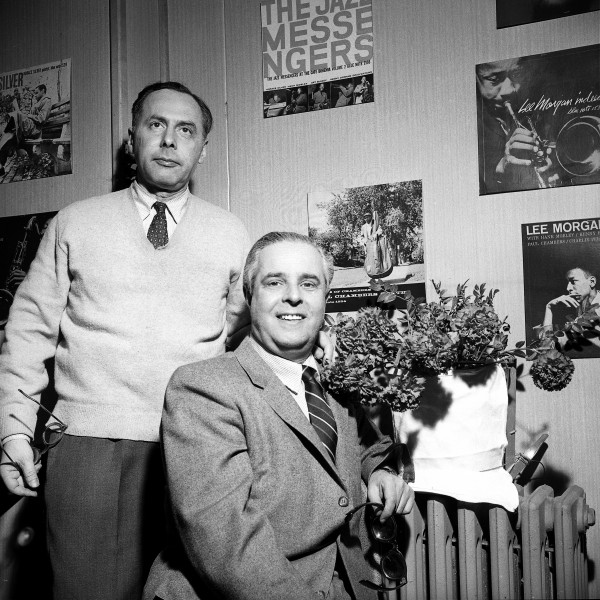
FRANCIS "FRANK" WOLFF AND ALFRED LION
A stunning German recreation of the world of Blue Note Records
There was a movie about this subject last year, Sophie Huber's 2018 Blue Note Records: Beyond the Notes. It's an interesting, well-made film about this key jazz record label and the pair of German Jewish immigrants, Alfred Lion, Francis Wolff, behind it. But you won't ask why there should be another film so soon when you see this one.
This is a bigger production and a German one, executive produced by Wim Wenders and directed by the major German documentary filmmaker, Eric Friedler. The result is a rich experience. There is a parade of jazz greats, just about anyone still living who recorded during the glory days from 1939 to 1965. Beyond that, there are the visuals. The script by Silke Schütze and the director Eric Friedler called for thirty minutes of animation to bring lost moments of Alfred and Frank's world in Germany and America to life. These are done in an original way that's stylized but fairly realistic. Toward the end there is a sequence of really snappy, gorgeous animation showing how the graphics of some of the classic Blue Note album covers are put together: it's a delight to the eye. The constant excerpts of key recordings alternate with the eye candy of the special visuals while the voices of jazz greats like Sonny Rollins, Herbie Hancock, Lou Donaldson, and Wayne Shorter, alternating with narration by several jazz historians, tell us what Blue Note was like. It's an impressive mix, and beautifully organized.
It was like a family. Frank and Alfred treated their African American musicians, victims of racism, with kindness because they were themselves refugees from extreme persecution. We hear at length about the recording sessions, very late at night, the drinks and sandwiches provided for all sessions, the taxis later to New Jersey to Rudy van Gelder's recording studio, the unique respect, and in the Sixties, the way Blue Note played a part in the civil rights movement. Alfred and Frank were always crusaders for civil rights. They valued their musicians. They also focused on modern jazz, not the retro stuff, and they let the musicians play what they wanted to play - though indeed, always there, paying attention, dancing a silly little off-beat jiggly dance (noted in the other film) when happy, insisted when they were not that the piece should be played again, because it "must schwing."
Each talking head contribution is in itself a portrait of the artist. It's extraordinary to hear at length from Sheila Jordan, a key jazz vocalist who is not 90, and still looks really good, hair and makeup immaculate. It's a little surprising that Ron Carter, the stellar bassist who has had a million recording dates, is still angry at the prejudice he experienced. Wayne Shorter, so enigmatic and sad as a player, is bubbly and full of smiles in speech. Rudy van Telder, 91, is giving his last interview. Lou Donaldson, 92, provides an essential running narrative in his high-pitched voice.
When Monk came along, it's acknowledged that he represented genius, and time is taken to listen to him and talk about him and watch him at work, including the spinning.
The film takes time to talk about too many individual recordings and artists to note here. One that stands out is perhaps their earlierst hit, Sidney Bechet's "Summertime," signaled as music whose soulful sweetness still resonates today. Of Blue Note's 1000 record albums, it's been said that 750 are classics. A lot of attention is paid to the distinctive Blue Note recorded sound and of the evolution of the recording studio, and the uniquely positive atmosphere Frank and Alfred maintained.
Pretty much any major jazz performer in the early years not included in this group who talk on camera simply isn't around anymore. Missing giants include John Coltrane, Monk, bebop keyboard pioneer Bud Powell, Art Blakey, Clifford Brown, Miles Davis, Joe Henderson and Jackie McLean. But we hear about them, especially Thelonius (who, we are reminded, nobody called that: he was "Bubba").
Another unique aspect of this film is its featuring of copious dialogue in German, both Alfred speaking and German announcers in New York broadcasting in the Thirties to Germany. It's stressed that both Alfred and Frank came from a part of the German Jewish population who considered themselves far more German than Jewish, in fact hardly Jewish at all, because they were not religious or particularly ethnic, and were very imbued with a sense of their German culture. (Neither of them ever lost his heavy German accent.) Alfred's England-based nephew points out his uncle's sense of Germanness. Perhaps this is a reason why Frank delayed a couple years coming to New York even though the Nazi scourge was clear. Frank was a photographer, had been from when the two met and became friends at the age of 16, and Frank and Alfred both loved jazz when the met, too.
This film talks more about Alfred as the one who ran the business till his retirement forced by ill health. But it delves further into the reclusive, private personality of Frank, giving numerous descriptions of what he was like by the musicians and revealing his black girlfriend even Alfred hadn't know of, who was present at his funeral with her children. The film warmly recreates the pair throughout in the animations, and presents interviews with both Alfred's wives. This, like the previous film, talks about Frank's omnipresent photo-making at recording sessions and at other odd moments. The film is full of Frank's striking black and white stills of the musicians making music, which make the essential part of some of the best of the albums. The other film shows a lot of the album covers too, but this one has the graphic animation of covers that is so dazzling and delightful.
In fact, it's hard to think of anything that could be better in this film, except sitting all day and listening to Blue Note Albums on a classic hi-fi record player. This is one of the best films about jazz in a while.
It Must Schwing: The Blue Note Story, 115 mins., debuted at Munich July 2018; also played at Telluride and Warsaw. It was screened for this review as part of the SFJFF. Jazz fans, don't miss it!
SFJFF showtimes:
Saturday July 20 1:15 Castro Theater
Tues., July 23 12:30 CineArts
Sat. July 28 1 pm Albany twin
FILM WEBSITE
TRAILER
Last edited by Chris Knipp; 07-19-2019 at 04:25 PM.
-
LEONA (Isaac Cherem 2018)
ISAAC CHEREM: LEONA (2018) CAPSULE
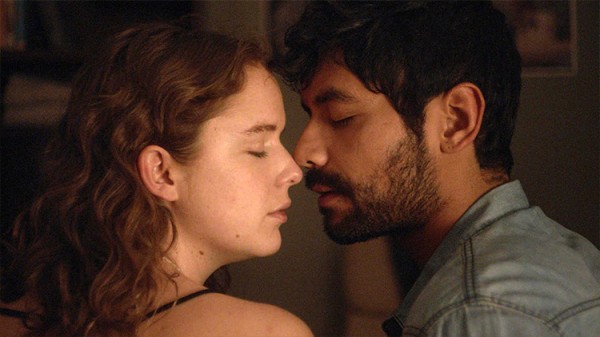
NAIAN GONZÁLEZ NORVIND, CHISTIAN VAZQUEZ IN LEIONA
Capsule review
Ariela (the disarmingly open Naian González Norvind, who co-scripted), is a 25-year-old Mexico City muralist from an observant, upper middle class Jewish family who falls in love (secretly, but not for long) with Iván (Christian Vazquez) an attractive, artistic non-Jewish man with whom she feels a lot in common. Her community is not amused. This film treats in specific detail a subject the outside world doesn't hear about. The 26-year-old director knows whereof he speaks, and the inbred M.C. Jewish community reportedly has not reacted favorably to this film. These people are very well off. Why must their society be so closed? Because, we're told, they came here 100 years ago, refugees from Syria, with nothing, and built it all up by rigid cooperation. In ghettos and shtetls, Jews were once inbred by necessity. Here and now they are so by choice. Assimilation into the goy world by a young woman isn't tolerated by this society, whose marriage and family rules seem more 19th than 21st century. Ariela must be a leona, a lioness: but she may not be up to it. A quiet shocker that mixes romance and ethnography.
Leona, 95 mins., debuted Oct. 2018 at Morelia (Michoacán, México) and has played at 16 Jewish Film Festivals plus the SFJFF, where it was screened for this capsule review.
SFJFF showtimes:
Sunday, July 21 8:45 pm CineArts
Wed. July 24 4:15 pm Castro
Sat. Aug 3, 6:35 pm Piedmont Theater
Sun., Aug 4 8:45 pm Smith Rafael
Best review I've seen is in Spanish by Alejandro Jiménez on Letterboxd.
Last edited by Chris Knipp; 07-21-2019 at 10:10 AM.
-
THE TOBACCONIST/DER TRAFIKANT (Nicolaus Leytner 2018) CAPSULE
NIKOLAUS LEYTNER: THE TOBACCONIST/DER TRAFIKANT (2018) CAPSULE
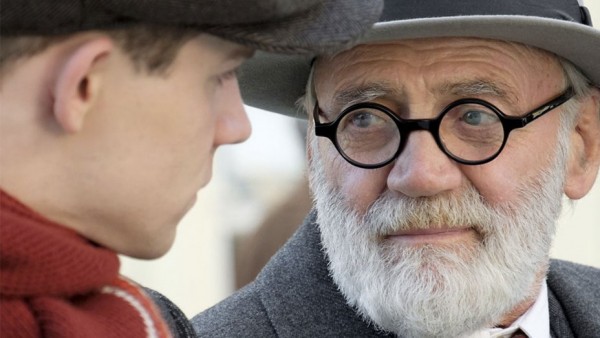
SIMON MORZÉ AND BRUNO GANZ IN THE TOBACCONIST
CAPSULE review - theatrical release coming soon
". . . a stunning recreation of the late 1930s in Vienna, thanks to the talents of director Nikolaus Leytner, his cinematographer and art director. The film expertly captures the tensions in the Austrian capital on the eve of Hitler’s takeover, and it also manages to be a vibrant coming-of-age story and an intriguing portrayal of Sigmund Freud, expertly portrayed by Bruno Ganz." - Stephen Farber, Hollywood Reporter.
In the first shot 17-year-old Frantz Huchel (robust young Everyman Simon Morzé) is hiding underwater in the lake as a thunderstorm rages, the water seemingly a safe cocoon for him. Out in the storm his promiscuous mother's latest lover, post copulation, takes a dip and is destroyed by lightening. Deprived of this source of livelihood, Mom sends Frantz to Vienna to apprentice to another lover, the tobacconist and one-legged WWI vet Otto Trsnjek (Johannes Krisch). Franz enters a miniature storybook world of Thirties shopkeeping, complete with period pornography hidden in a drawer for certain customers, all newspapers save the Nazi one, and a box of the best Havana cigars for the most special customers. Frantz sleeps in the shop, Otto at an apartment elsewhere.
The best touch in this atmospheric and visually pleasing but intellectually lightweight film (its YA storyline is never a total washout but sometimes belies its satisfying mise-en-scène) is what happens to Frantz at the end, as officials and bullies advise him to go back home but the future doesn't look rosy anywhere. He simply disappears, and the movie fades to black. Freud is gone, the shop has been closed, the Gestapo has the keys, the box of Havana cigars is left behind. The cozy, delightful mise-en-scène is plastered over with swastikas. What's left? Only tuneful credits roll. And credit is indeed deserved for dp Hermann Dunzendorfer and especially for production designer Bertram Reiter.
The Tobacconist/Der Trafikant, 117 mins., debuted at Hamburg Sept. 30, 2018 and had its US premiere in Jan. 2019 at the NYJFF at Lincoln Center, showing in numerous other Jewish film festivals including the SFJFF, where it was screened for this review.
SFJFF showtimes:
Tuesday July 23, 2019 8:10 p.m. CineArts
Thursday July 25, 2019 8:55 p.m. Castro Theatre
Saturday August 3, 2019 1:35 p.m. Smith Rafael
Sunday August 4, 2019 6:15 p.m. Piedmont Theatre
Last edited by Chris Knipp; 07-25-2019 at 10:11 AM.
-
TEL AVIV ON FIRE (Sameh Zoabi 2018)
SAMEH ZOABI: TEL AVIV ON FIRE (2018) CAPSULE
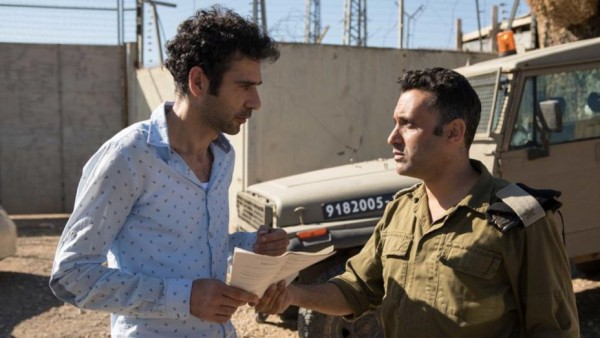
KAIS NASHIF AND YANIF BITON IN TEL AVIV ON FIRE
Israeli and Arab meet over a soap opera
The comedy follows Salam (Kais Nashif of Hany Abou-Assad's tense 2005 thriller Paradise Now), a scrawny Palestinian loser who gets successful as writer for a 1967-set Palestinian TV soap with a female spy, a terrorist, and an Israeli general when an unlikely alliance develops between him and an Israeli checkpoint officer (Yanif Biton) who wants to manipulate the action to please his wife: the show is a hit with Israeli as well as Arab audiences. The film plays with writers constantly changing endings and adding far-fetched twists, and is as silly as the soap it encompasses. But it takes us to a fanciful, less grim occupied land where Arabs and Jews mix in the name of silly melodrama. Alas, if Jay Weissberg's Variety review is right, for this film, "Israeli money means Arab play is impossible." As is shown in the film, fantasies of Israeli-Palestinian reconciliation are just that. I came to like the loose-limbed style of Kais Nashif and the way the film feels as thrown-together as the soap it depicts. Director Sameh Zoabi is from a tiny Palestinian town but studied at Colombia and teaches at NYU.
[I]Tel Aviv on Fire[/I تل أبيب على النار], 100 mins., debuted in the Orizzonti section at Venice Sept. 2, 2018 (Best Actor for Kais Nashif) and played at many international film festivals, now in Jewish film festivals, including SFJFF for this review. A limited US release starts July 26, 2019. Now showing at Quad Cinema, Landmark at 57 and the Beekman Theater in NYC. Coming to SF Bay Area: Aug. 9 following at Landmark’s Clay Theatre. San Francisco and Landmark’s Shattuck Cinemas, Berkeley.
Last edited by Chris Knipp; 08-09-2019 at 12:56 AM.
-
STANDING UP, FALLING DOWN (Matt Rattner 2019)
MATT RATTNER: STANDING UP, FALLING DOWN (2019)

BEN SCHWARTZ, BILLY CRYSTAL IN STANDING UP, FALLING DOWN
Two comics walk into a bar. . .
"I was smoking weed with my dermatologist. . ." The lead in Standing Up, Falling Down (a too-graphic title) uses his real life for comedy and is fed the possibility of that line by new circumstance. He acquires a dermatologist, with whom he almost immediately smokes weed.
Clowns in drama are usually sad and here you have two of them. No matter that Billy Crystal plays Marty, an alcoholic dermatologist in east Long Island. To us he's still a comic, the more famous one. He plays opposite Ben Schwartz, also a comic who has played many small roles in TV and film. Is this perhaps Schwartz's best, biggest one? He's loose, appealing, and smart as Scott, an aspiring comedian who has run out of money after four years in Los Angeles attempting to succeed at standup. He is back home in his old bedroom at loose ends, living with his mother (Debra Monk), his distant businessman dad (Kevin Dunn) and his scoffing adult sister Megan (Grace Gummer). His is 34 and unemployed. His sister is 30, working in a pretzel shop, and dating a security guard. Scott goes for a drink at a bar and the drunken man in a fedora he meets in the men's room peeing into the sink, Marty (Billy Crystal) turns out to be a dermatologist. Scott sees Marty in his office for his arm rash, which turns out to be due to stress. He gets some free cream because he can't afford to pay for meds, and they become pals, getting high together.
This fills a need for both of them. Marty is lonely and alcoholic. His duties don't seem very demanding. He hasn't always been this way; it happened with the decline of his clinically depressed second wife; both wives died. See what I mean about clowns being sad? He'd like to fight his way back. He and Scott hit it off. Scott is stressed (hence the rash) and awkward and disappointed with himself. It's hard facing the old place, the old people. Marty is good company, an inspired drinking partner. But Scott discovers that "34-year-old hangovers feel like brain cancer."
We've briefly seen Scott performing, before his return home. He's loose, smart, entertaining, and real. We see him doing standup again briefly at Governors of Levittown. Again he's funny and real. All his humor this second time comes from the events we have just seen. It's like a review of the action so far, recast as humor. Nice. He is good playing off the mike. Most of the time everyone else is somehow playing off him.
Does Billy Crystal get to do standup? Obviously not. But let's just say Marty's quick on his feet. And while he's a drunk, he has some wisdom to offer to Scott. One nugget that's underlined: "Regret's the only thing that's real." Crystal deserves credit for being good every moment without ever hogging the screen or playing Marty like a comedy routine. Marty's an amusing drunk, good company to some (not the barman, who's sick of him), but when he goes home, very alone.
The setup has nowhere to go but down or nowhere at all, because it refuses any schmaltzy bright new dawns for either of the two men. Even seeming successes, like Scott's appearance at Governor's, seem to fall flat. The fact that the flame still burns for him with his beautiful ex, Becky (Eloise Mumford), is just trouble, since she's happily married, or at least her jocky husband Owen (John Behlmann) thinks so. Mabye there are a few too characters, and some, like large local comic Murph (Leonard Ouzts), barely get a line or two. Nonetheless the main secondary characters, Scott's sister, her "awesome" boyfriend Ruis (David Castañeda), his annoying but caring mom (Debra Monk);, Marty's buddies at the bar, his unforgiving son Adam (Nate Corddry), his daughter (Caitlin McGee), even Scott's indifferent dad, are all made three-dimensional thanks to good casting, Peter Hoare's writing, and first-timer Matt Rattner's direction.
There are good scenes, some funny, some not. The meet-cute in the men's room is the first. Another comes when Marty and Scott are stoned in his "Snoop Dog" Seventies Caddy and Ruis, the sister's security guard boyfriend they've only heard about, comes up playing like a cop and scares them to death. Probably all of this is cliché, including the funeral taken over by the recent friend who delivers the most touching elegy. But Cristal and Schwartz are fun to watch, and this is a calling card for Matt Rattner.
Standing Up, Falling Down, 91 mins., debuted at Tribeca Apr. 25, 2019. It has been screened for this review as part of the SFJFF.
SFJFF showtimes:
Thursday July 25, 2019 6:00 p.m. CineArts
Saturday July 27, 2019 6:05 p.m. Castro Theatre
Sunday July 28, 2019 3:25 p.m. Albany Twin
Saturday August 3, 2019 6:25 p.m. Smith Rafael
Last edited by Chris Knipp; 07-22-2019 at 05:57 PM.
-
BEYOND THE BOLEX (Alyssa Bolsey 2018)
ALYSSA BOLSEY: BEYOND THE BOLEX (2018) CAPSULE

JACQUES BOLSEY IN BEYOND THE BOLEX
Capsule review
A documentary about the filmmaker's great-grandfather, Jacques Bolsey, a Jewish Russian refugee who emigrated to America. We learn about Bolsey and his famous invention, the "Bolex" portable movie camera, a design that became a classic and favorite of filmmakers looking for quality and portability. Alyssa Bolsey makes good use of a recently discovered archive - a family attick loaded full of Bolsey's inventions and papers - to explore the inventor's, and the invention's, history. Alyssa Bolsey devoted her life to this project for a dozen years, and it shows in the depth and richness of information provided in this fascinating film.
Bolsey was of Russian Jewish origin, but emigrated to Switzerland at an early age. His original name was Jak Bogopolsky. His runaway creativity as an inventor may have been against his own interests financially; in any case he was never after wealth. His greatest invention was the portable 16mm. movie camera known as the Bolex. It's like the camera version of a Swiss Army knife, a durable, handy, infinitely flexible tool that has inspired many photgraphers in their early work, some experimental ones throughout their careers, and it is still manufactured today. Some who used it: Bruce Brown, Jonas Mekas, Darren Arronofsky, Stephen Speilberg, Christopher Nolan, Wim Wenders, Ridley Scott, David Lynch, Michel Gondry. And that's that's just a few. It's used in filmmaking classes at the New School. And on and on.
Beyond the Bolex, 80 mins., with a 52 min. Arte version, was released at DOC NYC Nov. 2018. Screened for this capsule as part of the SFJFF 2019.
SFJFF showtimes:
Thursday July 25, 2019 6:00 p.m. CineArts
Saturday July 27, 2019 6:05 p.m. Castro Theatre
Sunday July 28, 2019 3:25 p.m. Albany Twin
Saturday August 3, 2019 6:25 p.m. Smith Rafael
Last edited by Chris Knipp; 07-23-2019 at 10:32 PM.
-
HENRI DAUMAN: LOOKING UP (Peter Kenneth Jones 2018)
PETER KENNETH JONES: HENRI DAUMAN: LOOKING UP (2018)
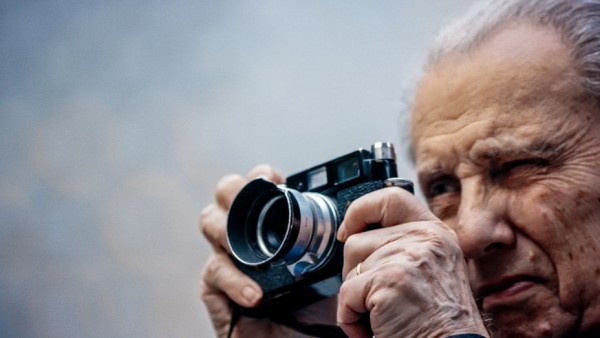
HENRI DAUMAN BEHIND A LEICA IN HENRI DAUMAN: LOOKING UP
A brilliant French lensman with a difficult past
"Looking Up," which refers to Henri Dauman's early photos of skyscrapers from below in New York, is the title of a retrospective of his photographs shown in Los Angeles at at KP Projects/Merry Karnowsky Gallery April 28 to May 12, 2018. This film is a follow-up, a personal review of his life and career. He flourished during the heyday of magazine photography in the Fifties and Sixties, before the decline of journalist caused hard times. That was his first US exhibition, we learn. The photographs are wonderful. Some of them, like Kennedy family marching in JFK's funeral cortège, are famous, but his name is too little known.
Dauman became a leading photojournalist after he emigrated at 17 in 1950 from France to New York. His work eventually was seen by millions in Life and on the covers of Time and L'Express, Epoca and Paris Match.. His photos are "a who's who of pivotal figures of the 20th century, including John and Jackie Kennedy, Marilyn Monroe, Andy Warhol, Brigitte Bardot, Elvis Presley and countess others," wites Frank Schenk in his Hollywood Reporter. review.
In Peter Kenneth Jones's documentary, Dauman tells his own story into the camera, much like Toni Morrison in the currently showing The Pieces I Am - but with a lot of lovely still photographs, which he explains were always informed by his love of films, especially American noir. He told only his two wives about his very difficult early years we learn of here. A Jew born in Montmartre, Dauman and his mother escaped the infamous "rafle" of the Vélodrome d'Hiver in Paris where thousands of Jews were taken to be sent off to their deaths at the hands of the Nazis. He was separated from her during the war as he fled into the country in hiding. His father was sent to Auschwitz and killed. Reunited with his mother in Paris after the Liberation when he was 9, he lost her again when she was one of six poisoned by an evil neighborhood pharmacist. He was in a succession of orphanages age 13-17. He taught himself photography and was already a success as a teen, doing, the French Wikipedia article tells us, "portraits of celebrities for Radio Luxembourg and the famous Agency stars Bernand."
The French government helped him find his American uncle Sam in New York to be his guardian and sailing on "the newly renovated liner La Liberté he went to America at 17. The time was rough here to. His uncle's wife wasn't friendly. He was housed in a room in the Bronx and worked in a lingerie factory. But he stuck to photography and, working like a demon, starting with the magazine France-Amérique, made a name for himself photographing celebrities, especially French ones, gaining note for a series on Elvis Presley doing military service. The Wikipedia article reviews Dauman's extensive achievements, which include color photography and directing documentaries. Some of these things the film barely touches on. At the end it lavishes much attention on Dauman today, his second wife, the two of them visiting a beautifully photographed Paris, and his children and grandchildren, whom he understandably considers his greatest achievement, since he started with nothing on arriving in the US. It's difficult to do full justice to both the private and professional life of this brave and prolific man. The director, Peter Jones, is the boyfriend of Dauman's granddaughter, Nicole Suerez. Dauman’s son, Philippe, is president, CEO and chairman at Viacom, heir apparent to the media empire long helmed by Sumner Redstone. Henri Dauman also has a daughter, Suerez’s mother, and another son from a second marriage.
Henri Dauman: Looking Up, 86 mins., debuted at the Hamptons Oct. 6, 2018. Screened for this review as part of the 2019 SFJFF.
Showtimes SFJFF:
Thursday July 25, 2019 11:40 a.m. CineArts
Friday July 26, 2019 11:15 a.m. Castro Theatre
Wednesday July 31, 2019 1:30 p.m. Albany Twin

A WIDELY SEEN DAUMAN PHOTO: THE JFK FUNERAL CORTEGE
Last edited by Chris Knipp; 07-24-2019 at 07:33 PM.
-
ADVOCATE (Rachel Leah Jones, Phillipe Bellaiche 2019)
RACHEL LEAH JONES, PHILLIPE BELLAICHE: ADVOCATE (2018) CAPSULE
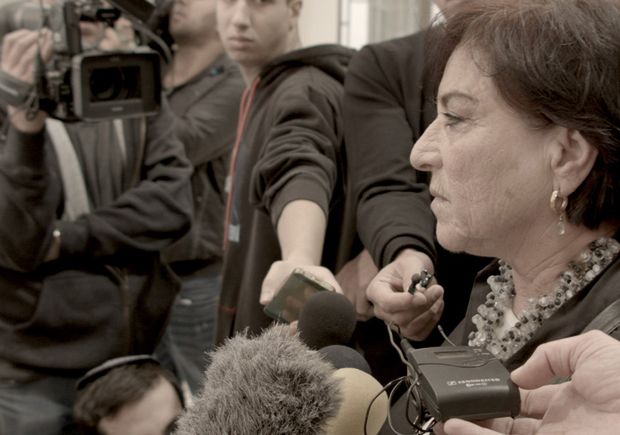
LEA TSEMEL
Capsule
Advocate is a documentary about vibrant Israeli human rights lawyer Lea Tsemel who has represented political prisoners for nearly 50 years. In his Hollywood Reporter review written at HotDocs, Keith Uhlich calls this film "absorbingly up close and personal." There have been several boldly revealing Israeli documentaries, namely The Gatekeepers (NYFF) and The Law in These Parts (SFIFF). There was also The Lab (SFIFF), an eye-opening film about Israeli's huge arms production and sales. In 2018 came Duki Dror's The Mossad (SFJFF), about Israel intelligence. Rachel Leah Jones's and Phillipe Bellalache's Advocate must be added to this impressive list.
Advocate, 108 mins., debuted at Sundance Jan. 2019 and has played in at least 9 other international festivals, including SFJFF, where it was screened for this capsule comment. In June it was the Opening Night film of the Film at Lincoln Center Human Rights Festival. At Docaviv it won first prize.
SFJFF showtimes:
Saturday July 27, 2019 3:20 p.m. Castro Theatre
Sunday July 28, 2019 5:55 p.m.Albany Twin
INTERVIEW about the film on Democracy Now!
Last edited by Chris Knipp; 08-01-2019 at 01:43 PM.
-
BLACK HAT (Sarah Smith 2019) 14-minute short
SARAH SMITH: BLACK HAT (2019)
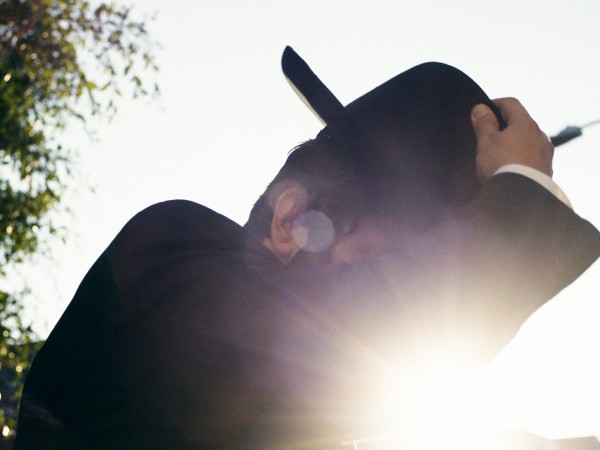
Forbidden sexuality in the Orthodox community
In this 14-min. film Shmuel (Adam Silver), a Hasidic Jew, sneaks off at night, his payot tucked into a watch cap, his black hat in a bag, to go to a nearby gay bar where he drinks and eventually makes out in the back room with an interested, attractive young black guy called Jay (Sebastian Velmont). In the excitement, he repeats something he has done even at shul: he forgets his black hat. Unknown to him, there is a sympathetic colleague, Jacob (Alan Lennick), sitting at the bar, who recognizes him, and returns the hat to him at shul the next day. The film dramatizes the fact that queerness isn't normally okay in the Hasidic world. Needless to say, it exists. This is just a sketch, with an atmosphere of the furtive, a lot of dithering for such a short film. For a full-fledged painting, see Haim Tabakman's stunning 2009 feature Eyes Wide Open about forbidden love between two gay butchers in the ultra-Orthodox community of Jerusalem, which ends tragically. There is a review-comment by Danielle Solzman on Sarah Smith's short from the viewpoint of an Orthodox person who identifies as transgender. She mentions the star-studded Orthodox lesbian tale Disobedience, with Rachel McAdams and Rachel Weisz, which we reviewed here last year.
Black Hat plays with the feature City of Joel, a documentary feature by Jesse Sweet about political conflict with the Kiryas Joel ultra-Orthodox community in Orange County, California when it seeks to expand.
Black Hat, 124 mins.., debuted at Toronto Sept. 2019 with its US premiere at Tribeca. fOURTEEN FESTIVALS LISTED ON ITS POSTER, AND IT HAS played at various Jewish film festivals; screened for this review-comment as part of the SFIFF.
SFJFF showtimes for City of Joel:
Monday July 22, 2019 1:15 p.m. CineArts
Thursday July 25, 2019 3:45 p.m. Castro Theatre
Tuesday July 30, 2019 1:00 p.m. Albany Twin
Last edited by Chris Knipp; 07-22-2019 at 08:57 AM.
 Posting Permissions
Posting Permissions
- You may not post new threads
- You may not post replies
- You may not post attachments
- You may not edit your posts
-
Forum Rules





 Reply With Quote
Reply With Quote















Bookmarks